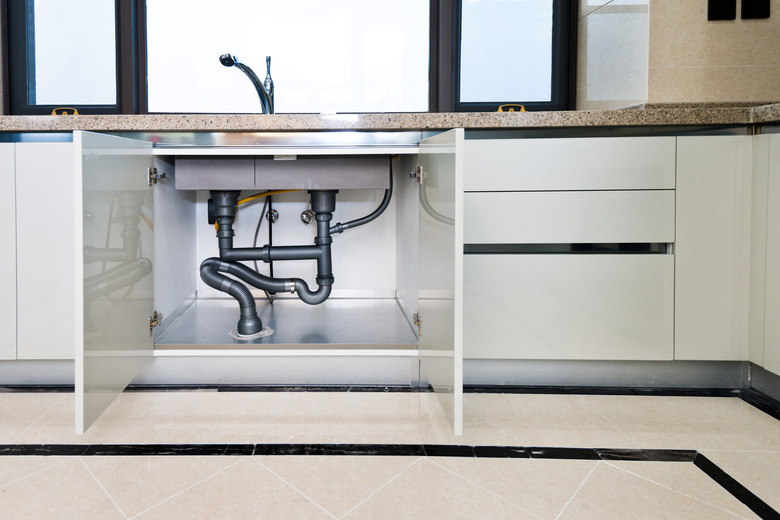Under Sink Air Gap Installation
Air gaps create an outlet between waste water drain lines and appliances that discharge water, such as dishwashers and water filtration systems. A dishwasher air gap is code in many jurisdictions, though some allow an alternative installation method.
Mounted to the rim of a kitchen sink, the air gap's outlet intercepts and empties waste water from clogged drains before it can flow through the appliance's drain hose and into the appliance. An air gap's under-sink installation requirements vary according to specific circumstances, such as the presence of a garbage disposal unit and the location of drainpipes.
Air Gap Assembly
Air Gap Assembly
An air gap assembly consists of two hoses, under-sink piping and a decorative cap. Air gap hoses are typically flexible rubber or plastic. An air gap's under-sink piping resembles an upside-down "Y." Thus, the branched end of the pipe extends into the cabinet below the sink, and the straight stem of the pipe protrudes from the sink's rim. Usually painted or coated with a faux-chrome finish, the decorative cap snugly fits over the protruding pipe.
Location for Installation
Location for Installation
Standard sink basins include three to five holes across their rear edges. Three of the holes accommodate a faucet assembly: one hole for the faucet stem and two holes for the faucet handles. Additionally, holes along the sink's rim accommodate an air gap assembly or a sink sprayer fixture.
Before beginning the under-sink portion of an air gap assembly, you must pry the protective cap from an available hole with a screwdriver. If a sink sprayer occupies the only available hole, you must either remove the sprayer to make room for the air gap or drill a new hole. If you're a visual learner, you can find numerous online videos, often from longtime plumbers, which will walk you through the installation process and its options.
Air Gap to Drainpipe
Air Gap to Drainpipe
One of the air gap's drain hoses connects to an appliance, such as a water filtration system or a dishwasher, and the opposite hose joins the kitchen sink's drain line. The most basic drain connection routes the air gap hose directly to a specially designed, branched drainpipe. The pipe connects at one end to a sink basin's strainer and the opposite end to the sink's P-trap. A small tube protrudes from the center of the pipe, precisely sized to accommodate an air gap drain hose. Air gap drain hose pipes connect to all fittings via mechanical clamp fittings.
Air Gap to Garbage Disposal Unit
Air Gap to Garbage Disposal Unit
All garbage disposal units are designed to accommodate air gap drain hoses. As with branched, drain-extension pipes, a small tube protrudes from the side of garbage disposal units. Similarly, the air gap drain hose connects to the disposal's tube via a mechanical clamp fitting. However, manufacturers plug the tube with a metal plate during production. The metal plug allows a single unit to accommodate sinks with both air gaps and without air gaps. To remove the plug, you must punch it toward the disposal's interior with a screwdriver.
In some jurisdictions you may be permitted to connect your dishwasher to a garbage disposal without an air gap, using the high loop method, though it's not as safe as an air gap.
